Zoom
Trash

Examples of work our art+botany class students turned in for their second assignment: "Revising" a floral image on an object/textile to show "the goods" that were excluded/hidden. On herbarium paper. #bisonflowers #sciart #iamabotanist @annakkell. Building the Bioeconomy Workforce of the Future. Skip to Main Content Advertisement Search Close Advanced Search Search Menu Skip Nav Destination Article Navigation Building the Bioeconomy Workforce of the Future Jyotsna L Pandey Jyotsna L Pandey American Institute of Biological Sciences Search for other works by this author on: Oxford Academic.

□We're offering another #herbarium internship for the spring 2021 semester! Students will be able to gain hands-on experience w/ a #naturalhistory #collection on campus while earning 2-3 course credits. Check out the flier for details! □@UTK_EEB @UTPlantS. QUBES - Resources: Biodiversity research using digitized, internet-based natural history collections. Undergraduate Resources. Collections-Based Online Resources for Undergraduate Students and Educators Tutorials iDigBio Basic Search Tutorial (Video) Created by Teresa Mayfield Searching for Species with Latitude and Longitude Data on iDigBio (PDF) Created by iDigBio GBIF Search Tutorial (Video) Created by Teresa Mayfield Create an Arctos User Account (Video) Created by Teresa Mayfield Arctos Introduction for Non-managers (Video) Created by Teresa Mayfield Uploading an Observation to iNaturalist via the Website (Video) Created by Erica Krimmel iNaturalist Search Tutorial (Video) Created by Teresa Mayfield Modules and Online Resources Using Digitized Collections-Based Data in Research: A Free hands-on crash course in ecological niche modeling Provides step-by-step, hands-on instruction on ways to access and download these specimen data, how to process climate layer data, and how to apply Maxent software to construct ecological niche models.
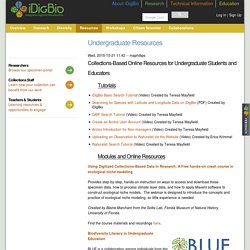
Collecting a Specimen. Mounting a Specimen. Plant Ecology in a Changing World - Syllabus. Did the "craft flowers" exercise in my plants class night. This reinforces basic flower concepts we just learned (flower symmetry, merosity, stamen position, corolla fusion, etc.). Thanks @MLinkPerez for the idea! #WichitaState. Biography of A Natural Historian. Proud new #herbarium parents with their mounted specimens. No weights were stuck on - well done! #mscsiss #mscpldiv @readingbotany.
Plant mounting party @GSUHerbarium. How students can make a plant press from materials in the recycling bin - #COVID19 teaching solution by @tobiaspolicha for #remotelearning of #botany, now available for free on #BotanyDepot. You work with what you've got and it works! #Iamabotanist @uoreg. TENN Specimens and Scones. How many people does it take to revise a genus? In 1994 I was in a forest in the Central African Republic standing in front of a tree.
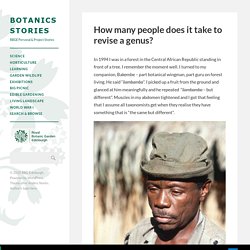
I remember the moment well. I turned to my companion, Bakembe – part botanical wingman, part guru on forest living. My first taxonomic revision – experiences from the Edinburgh herbarium – by Julia Wellsow. Desplatsia is a genus of small trees growing in the forests of West and Central Africa.
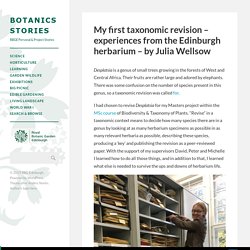
Their fruits are rather large and adored by elephants. Making and Knowing. The Making and Knowing Project, founded in 2014 by Pamela H.
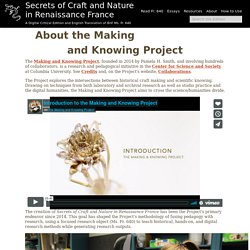
Smith, and involving hundreds of collaborators, is a research and pedagogical initiative in the Center for Science and Society at Columbia University. See Credits and, on the Project's website, Collaborations. The Project explores the intersections between historical craft making and scientific knowing. Drawing on techniques from both laboratory and archival research as well as studio practice and the digital humanities, the Making and Knowing Project aims to cross the science/humanities divide. Raising awareness about food security using a massive open online course - Stevens - BioGO, a treasure hunt to teach biology. Last semester we started the teaching season with a big challenge: teach an introductory biology class to 320 first-year students.

The formal aim of the course was to get the students familiar with plant and animal structures at different scales, and how these structures interact and function together. Aside from that we also wanted to teach them to observe the natural world. We wanted them to realise that they do not need to go to a natural park to see high levels of biodiversity. (30) DCU herbarium (Herb. Uni. Urb. Dub.) - HUUD (@DcuDub) / Twitter. New Teaching Tool, “Computational Microscopy: Revealing Molecular Mechanisms in Plants Using Molecular Dynamics Simulations” We’re excited to annouce the publication of The Plant Cell‘s latest Teaching Tool, “Computational Microscopy: Revealing Molecular Mechanisms in Plants Using Molecular Dynamics Simulations,” by Jiangyan Feng, Jiming Chen, Balaji Selvam, and Diwakar Shukla.
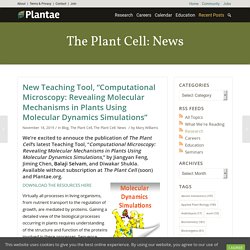
Available without subscription at The Plant Cell (soon) and Plantae.org. Virtually all processes in living organisms, from nutrient transport to the regulation of growth, are mediated by proteins. Gaining a detailed view of the biological processes occurring in plants requires understanding of the structure and function of the proteins involved in these processes. Sequence information is widely available for proteins across organisms, but structural information is still lacking, especially for plant proteins. Structural biology has provided valuable insights and high-resolution views of the biophysical processes in plants, such as photosynthesis, hormone signaling, nutrient transport, and toxin efflux. Dr. Dr. Teaching the Plants of Michigan (PLB218) course how to mount their specimens today! Protocols in Ecological Plant Physiology. French Botanical Network.
Hands on the Herbarium! – UGA Costa Rica Blog. William A.
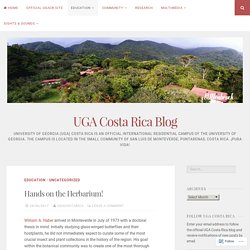
Haber arrived in Monteverde in July of 1973 with a doctoral thesis in mind. Initially studying glass-winged butterflies and their hostplants, he did not immediately expect to curate some of the most crucial insect and plant collections in the history of the region. His goal within the botanical community was to create one of the most thorough Costa Rican plant collections.
His success produced four duplicate copies of this particular collection: One at the Missouri Botanical Garden, two currently at the National Museum of Costa Rica, and one now with us, inherited from Haber himself in 2009. Undergraduates and the BHL. "Is the bald eagle really bald?
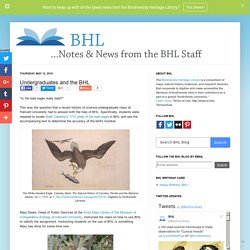
" This was the question that a recent history of science undergraduate class at Harvard University had to answer with the help of BHL. Specifically, students were required to locate Mark Catesby's 1731 plate of the bald eagle in BHL and use the accompanying text to determine the accuracy of the bird's moniker. Mary Sears, Head of Public Services at the Ernst Mayr Library of the Museum of Comparative Zoology at Harvard University, instructed the class on how to use BHL to satisfy the assignment.
Where have all the Botany degree Schemes gone? What is it that makes a plant science degree more attractive to students?
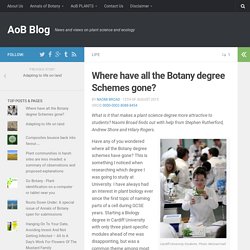
Naomi Broad finds out with help from Stephen Rutherford, Andrew Shore and Hilary Rogers. Cardiff University Students. Photo: Michael Hall Photography. Herbarium now open to students, public – The Campus Eye. Tucked in the Cambridge library is a variety of…herbs? Photographs of herbarium samples by Cassandra Fiskewold hover mouse over image for descriptions of samples The Russell Johnson herbarium is housed at the Cambridge campus library. The herbarium is a plant reference collection. Students can learn about botanical classification, plant relationships, plant preservation, storage techniques and shelving models. Brown U Herbarium: Student use. In the Brown University Herbarium, the digitization of tens of thousands of plants preserved over two centuries has opened the door to studies that span space, time and the diversity of nature. PROVIDENCE, R.I. [Brown University] — Behind a zigzagging glass wall that faces into the main floor hallway of Brown’s BioMed Center, junior Dan Davis spent a recent Friday morning bringing precious treasures of natural history into the digital age.
At the Brown University Herbarium, Davis — a dual concentrator in biology and music — has scanned thousands of pressed and dried plant samples into the facility’s rapidly growing public archive. He places each sample in a brightly lit box that in another existence might house items being photographed for sale on eBay.
A camera mounted above with the lens pointing downward snaps a perfect, high-resolution photo. The samples date back as far as the 1820s. Beyond the Bean Seed. Teach bio div nat hist coll: ref 2017. Biodiversity Literacy in Undergrad Ed. Bioinformatics competencies ref 2017. University of Florida Herbarium (FLAS) Herbarium Management Course Syllabus. Integrating Natural History Collections into Undergraduate Education: Creating the Resources and Growing the Community. Herbarium Specimen Label Tutorial.
Connecting Students to Citizen Science and Curated Collections. Five Lessons for Life from Working on the Horniman’s Historical Herbarium. Written by Imogen Crarer during a student placement at the Horniman Museum and Gardens early last year. Imogen recently graduated from King’s College, London with an MA in Modern History with Distinction and is currently training as a curator at the Museum of Cornish Life. You may think that I have taken slight leave of my senses or perhaps am being a pinch too ambitious in claiming that the Horniman’s historical botany collection is the source of 5 significant life lessons.
However, “Yes! To science and history but also yes to life!” Is my cheerful reply. Life Lesson Number 1: Often, the Simple or Basic Tasks are the Most Important. Everything starts somewhere. Having never previously been catalogued, the data from the handwritten labels on these specimens needed entering into the Horniman’s Collections Management System, Mimsy XG. The collections management database used by the Horniman Museum; Mimsy XG. © Horniman Museum and Gardens. Nature Is Risky. That’s Why Students Need It. My Classroom: Herbarium. Botany Depot – Educational inspiration and free teaching resources in botany. Manual: The Naming of Plants – explanations and examples, by Lena Struwe – Botany Depot. Looking for a non-technical beginners and intermediate users manual in plant nomenclature that explains scientific names, common names, cultivated and trade names, and what changes in plant classifications that could lead to name changes?
Here it is, free to download and use: This manual by Lena Struwe (Botanical Accuracy LLC) was sponsored by the Personal Care Products Council (PCPC) for the purpose to promote botanical accuracy and botanical education worldwide and is free to download and use by anybody interested in botany, horticulture, agriculture, herbal medicine, commercial plant products, and edible plants. Ickert-Bond Lab: systematics meets ecology, paleontology, and genomics. Natural History Collections: Teaching about Biodiversity Across Time, Space, and Digital Platforms.
Bay Nature: Why I'm Starting a College Natural History Program in 2018. When I started the Ph.D. program in Environmental Science, Policy & Management at UC Berkeley 12 years ago, I knew two things for sure: I loved islands, and I loved insects. Do you think a career in horticultural engineering could be for you? Are you interested in machinery and engines and want to learn more? We’re delighted to be able to offer an engineering apprenticeship opportunity @RHSBridgewater – closes 11th March! NMSU plant ID team in action. Great practice day! Recently in #324NatHist class we spent some time accessioning an interesting collection: about 300 slime mold specimens collected in the '60s by Dr. Ralph Troll and kept in cute match boxes #myxomycetes. Manual: The Naming of Plants – explanations and examples, by Lena Struwe – Botany Depot.